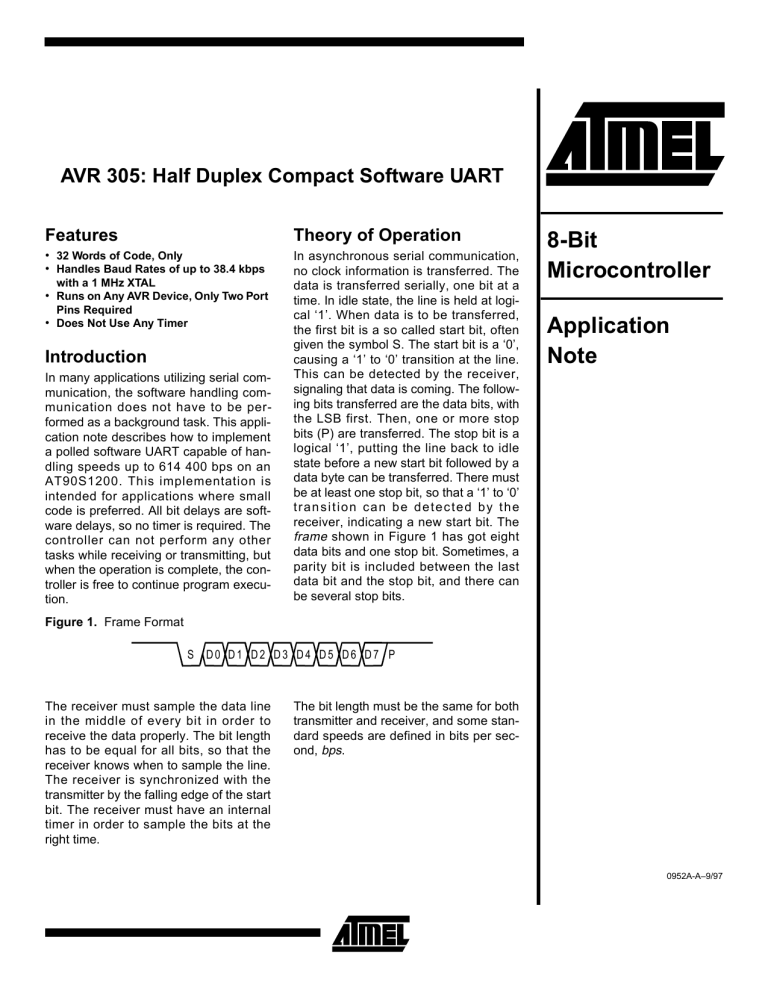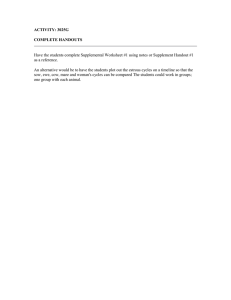
AVR 305: Half Duplex Compact Software UART Features Theory of Operation • 32 Words of Code, Only • Handles Baud Rates of up to 38.4 kbps In asynchronous serial communication, no clock information is transferred. The data is transferred serially, one bit at a time. In idle state, the line is held at logical ‘1’. When data is to be transferred, the first bit is a so called start bit, often given the symbol S. The start bit is a ‘0’, causing a ‘1’ to ‘0’ transition at the line. This can be detected by the receiver, signaling that data is coming. The following bits transferred are the data bits, with the LSB first. Then, one or more stop bits (P) are transferred. The stop bit is a logical ‘1’, putting the line back to idle state before a new start bit followed by a data byte can be transferred. There must be at least one stop bit, so that a ‘1’ to ‘0’ transition can be detected by the receiver, indicating a new start bit. The frame shown in Figure 1 has got eight data bits and one stop bit. Sometimes, a parity bit is included between the last data bit and the stop bit, and there can be several stop bits. with a 1 MHz XTAL • Runs on Any AVR Device, Only Two Port Pins Required • Does Not Use Any Timer Introduction In many applications utilizing serial communication, the software handling communication does not have to be performed as a background task. This application note describes how to implement a polled software UART capable of handling speeds up to 614 400 bps on an AT90S1200. This implementation is intended for applications where small code is preferred. All bit delays are software delays, so no timer is required. The controller can not perform any other tasks while receiving or transmitting, but when the operation is complete, the controller is free to continue program execution. 8-Bit Microcontroller Application Note AVR305 Figure 1. Frame Format S D0 D1 D2 D3 D4 D5 D6 D7 P The receiver must sample the data line in the middle of every bit in order to receive the data properly. The bit length has to be equal for all bits, so that the receiver knows when to sample the line. The receiver is synchronized with the transmitter by the falling edge of the start bit. The receiver must have an internal timer in order to sample the bits at the right time. The bit length must be the same for both transmitter and receiver, and some standard speeds are defined in bits per second, bps. 0952A-A–9/97 1 Implementation Bit Length Delays - UART_delay The delay between the bits are generated by calling a delay subroutine twice (as the subroutine generates a halfbit delay, see receiving data). If very short delays are required (when transmitting and receiving at very high speed), the delay must be implemented inside the putchar and getchar routines. The required delay length in clock cycles can be calculated using the following formula: If the delay is generated as shown below, the total execution time is 3·b cycles plus 7 cycles for rcall and ret. rcall UART_delay: ldi UART_delay1: dec brne UART_delay temp,b temp UART_delay1 ret The value b is found by the equation f CLCL c = -----------------bit rate c–9 ------------ – 7 2 c – 23 b = --------------------- = --------------3 6 where c is the bit length in clock cycles and f CLCL is the crystal frequency. Both putchar and getchar use 9 CPU cycles to send or receive a bit. Hence, a delay of c - 9 cycles must be generated between each bit. The rcall and ret instructions require a total of 7 cycles. If the subroutine is to be called twice to generate the required delay, the delay has to be d cycles: c–9 d = ------------ – 7 2 The actual delay generated, calling delay twice is d = ( 3 × b + 7 ) × 2 + 9 = 6 × b + 23 From this, the minimum and maximum delays are dmin = 29 and dmax = 1 559 cycles. The c and b values for some bit rates and frequencies are shown in Table 8. Table 1. “UART_delay” Subroutine Performance Figures Parameter Value Code Size 4 words Execution Cycles Min: 7 cycles Max: 772 cycles (including ret) Register Usage Low registers High registers Global :None :None :1 Table 2. “UART_delay” Register Usage Register Input R17 “temp” - count variable Transmitting Data - putchar The putchar subroutine transmits the byte stored in the register Txbyte. The data bits are shifted into the carry bit. The easiest way to generate stop bits is to let the zeros shifted into the transmitted byte be interpreted as ones. If the data byte is inverted before it is shifted, a ‘0’ in carry must give a ‘1’ on the line, and a ‘0’ in carry gives a ‘1’ on the line. When 0’s are shifted into the data byte, they are handled as 1’s. This way, any number of stop bits can generated by 2 Internal AVR305 Output AVR305 just repeating the transmittal loop. The start bit is generated by setting the carry bit before data are shifted out. Table 3. “putchar” Subroutine Performance Figures Parameter Value Code Size 14 words Execution Cycles Depends on bit rate Register Usage Low registers High registers Global :None :None :2 Table 4. “putchar” Register Usage Register Input Internal R16 Output “bitcnt” - counts the number of bits transfered R18 “Txbyte” - the byte to send The algorithm for transmitting data is shown in the flowchart: Figure 1. putchar subroutine putchar bit cou nter = 9 + sb sb = num be r o f stop bits In vert T xbyte S et carry 0 If carry is... T xD = 1 Receiving Data - getchar First, the routine waits for a logical ‘0’ (not a transition). When the start bit is detected, a 1.5 bit delay is generated. This is performed by calling the delay subroutine three times. Sampling then starts at 1 bit intervals. The carry is set or cleared according to the logic value at the RxD-pin. If less than eight data bits are received, the carry is shifted into the receive byte. If not, the routine returns with the received byte in Rxbyte. The routine waits for one bit length after the last data bit and terminates in the middle of the stop bit. This is done to 1 T xD = 0 delay delay S hift Txbyte righ t D e cre m ent bit cou nter Is bit coun ter 0? No Yes R e turn 3 prevent detection of a false startbit if the routine is called again immediately after a complete reception. Table 5. “getchar” Subroutine Performance Figures Parameter Value Code Size 14 words Execution Cycles Waits until byte received Register Usage Low registers High registers Global :None :None :2 Table 6. “getchar” Register Usage Register Input Internal R16 “bitcnt” - counts the number of bits received R18 “Rxbyte” - the received byte The algorithm for receiving data is: Figure 2. getchar subroutine putchar bit cou nter = 9 + sb sb = num be r o f stop bits In vert T xbyte S et carry 0 1 If carry is... T xD = 1 T xD = 0 delay delay S hift Txbyte righ t D e cre m ent bit cou nter Is bit coun ter 0? No Yes R e turn 4 Output AVR305 AVR305 Example Program The example program receives a character with getchar and echoes it back with putchar. Table 7. Overall Performance Figures Parameter Value Code Size 32 words - UART routines only 40 words - Complete application note Register Usage Low registers High registers Global :None :4 :None Interrupt Usage None Peripheral Usage Port D pin 0 and 1 (any two pins can be used) 5 Table 8. Baud Rate Table 1 MHz BaudRate 2400 4800 9600 14400 19200 28800 57600 115200 1.8432 MHz Cycles required 417 208 104 69 52 35 17 9 b-value Cycles required 1024 512 256 171 128 85 43 21 b-value Cycles required 1667 833 417 278 208 139 69 35 b-value Cycles required 3333 1667 833 556 417 278 139 69 b-value Cycles required 6144 3072 1536 1024 768 512 256 128 b-value 66 31 14 8 5 2 1 1 Error % 0.6 0.3 2.7 2.2 1.8 0.8 67.0 234.1 2.4576 MHz BaudRate 2400 4800 9600 14400 19200 28800 57600 115200 2400 4800 9600 14400 19200 28800 57600 115200 167 82 39 25 18 10 3 1 2400 4800 9600 14400 19200 28800 57600 115200 2400 4800 9600 14400 19200 28800 57600 115200 6 b-value Cycles required 1365 683 341 228 171 114 57 28 b-value Cycles required 1920 960 480 320 240 160 80 40 b-value Cycles required 3840 1920 960 640 480 320 160 80 b-value Cycles required 6667 3333 1667 1111 833 556 278 139 b-value 124 60 28 18 12 7 2 1 Error % 0.1 0.3 0.5 2.3 1.0 1.6 9.4 81.3 2400 4800 9600 14400 19200 28800 57600 115200 274 135 66 42 31 19 8 2 BaudRate 0.0 0.0 0.6 1.0 0.3 1.4 2.2 0.8 2400 4800 9600 14400 19200 28800 57600 115200 224 110 53 34 25 15 6 1 0.1 0.0 0.1 0.2 1.4 0.7 3.7 2.0 552 274 135 89 66 42 19 8 BaudRate 0.0 0.0 0.0 0.3 0.6 1.0 1.4 2.2 2400 4800 9600 14400 19200 28800 57600 115200 316 156 76 50 36 23 10 3 0.1 0.1 0.2 0.9 0.4 0.6 3.8 2.5 1020 508 252 167 124 82 39 18 BaudRate 0.0 0.0 0.1 0.1 0.1 0.6 0.4 2.3 AVR305 2400 4800 9600 14400 19200 28800 57600 115200 b-value Cycles required 1536 768 384 256 192 128 64 32 b-value Cycles required 3072 1536 768 512 384 256 128 64 b-value Cycles required 4608 2304 1152 768 576 384 192 96 b-value 135 66 31 19 14 8 2 1 Error % 0.0 0.6 0.3 1.4 2.7 2.2 0.8 67.0 BaudRate 2400 4800 9600 14400 19200 28800 57600 115200 252 124 60 39 28 18 7 2 Error % 0.1 0.1 0.3 0.4 0.5 2.3 1.6 9.4 BaudRate 2400 4800 9600 14400 19200 28800 57600 115200 508 252 124 82 60 39 18 7 Error % 0.0 0.1 0.1 0.6 0.3 0.4 2.3 1.6 11.059 MHz 636 316 156 103 76 50 23 10 Error % 0.0 0.1 0.1 0.2 0.2 0.9 0.6 3.8 16 MHz Error % 2400 4800 9600 14400 19200 28800 57600 115200 Cycles required 833 417 208 139 104 69 35 17 7.3728 MHz Error % 9.216 MHz Error % BaudRate 3.6864 Mhz Error % 4.608 MHz Error % 14.746 MHz BaudRate BaudRate 0.1 0.6 0.4 1.4 2.3 2.7 3.9 35.9 8 MHz BaudRate 2400 4800 9600 14400 19200 28800 57600 115200 2 MHz Cycles required 768 384 192 128 96 64 32 16 3.276 MHz Error % 4 MHz BaudRate BaudRate 1107 552 274 181 135 89 42 19 Error % 0.0 0.0 0.0 0.2 0.0 0.3 1.0 1.4 BaudRate 2400 4800 9600 14400 19200 28800 57600 115200 764 380 188 124 92 60 28 12 Error % 0.0 0.0 0.1 0.1 0.2 0.3 0.5 1.0

